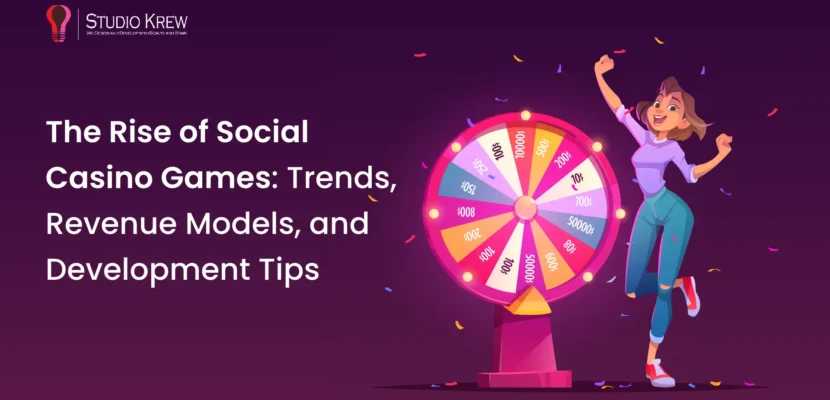Social casino games have rapidly emerged as a significant force within the gaming industry. Merging the thrill of traditional casino games with the social interaction and convenience of mobile platforms, these games have captivated millions of users globally.
Industry analysts project that the global social casino market will reach approximately $24.01 billion by 2025, driven by player demand for engaging, socially interactive gaming experiences that avoid the risks associated with real-money gambling. Players enjoy games like poker, slots, and roulette, using virtual currency within environments rich in community interactions, graphics, and real-time gameplay.
This blog explores the increasing popularity of social casino games, highlighting key trends, analyzing effective revenue models, and providing valuable development insights.
What Are Social Casino Games and Why Are They Popular?
Social casino games are like digital versions of your favorite casino games, but they’re all about having fun and connecting with others. You can play games like slots, video poker, blackjack, roulette, bingo, and popular card games like Texas Hold’em or Teen Patti using virtual tokens instead of real cash. Players can join public tables or create private games with friends, chat in real-time, and show off their skills on leaderboards. The big difference from regular online gambling is that social casinos don’t pay out in real money; instead, you use virtual chips or coins that can sometimes be bought with real cash, but those chips don’t have any cash value outside the game. There are some top casino game development company creating custom casino games for both mobile and web platforms under categories like Card game development and Slot game development.
So, what makes this model so popular? It’s all about the cool features that set social casino games apart from the rest!
Accessibility
The beauty of social casino games lies in their inclusivity. Anyone with a smartphone or computer can download a social casino app and start playing immediately without needing to visit an ATM or undergo age verification. This open-door policy fosters a sense of community among players, making everyone feel welcome and part of the fun.
Risk-free thrill
Social casino games offer an exhilarating experience without the anxiety of losing real money. The games are essentially free, allowing players to experience the excitement of gambling, including big wins and betting strategy, without any financial stakes. This unique blend of thrill and safety is a significant draw for casual players, keeping them engaged and entertained.
Social engagement
Social casino games are not just about playing; they’re about connecting with others. Players can invite friends to play at virtual tables, participate in tournaments, and showcase their winnings. The social features, such as chat rooms, friend lists, and community competitions, foster a sense of camaraderie among players. This strong community bond keeps players engaged longer than solitary play would, making them feel part of something bigger.
This sense of community keeps players engaged longer than solitary play would.
Platforms like Facebook, mobile app stores, and standalone websites have all become hubs for social casino games. Major titles (e.g., slot or poker apps) use 3D avatars, live tournaments, and even events tied to holidays or pop culture. Despite looking and feeling like casino games, players know they are just for fun. According to one review, social casino players span demographics because they “enjoy the thrill of gambling but prefer to avoid monetary stakes”. In short, social casino games have grown by offering a free, fun, and communal gaming experience that anyone can enjoy at any time.
Also Read: Play-to-Earn Games in 2025: Where Fun Meets the Future of Finance
Industry Trends Shaping Social Casinos
Social casino games have become so popular that the industry is undergoing rapid evolution. Looking ahead, several trends stand out as game-changers:
AI-Powered Personalization
Companies that focus on AI-Integrated game development services are making online casino games feel way more personal for players. Nowadays, people want games that adjust to how they like to play. For example, AI can tweak the difficulty level on the fly—changing how risky a slot machine is or matching the skill level of poker opponents to fit what a player can handle. Plus, it can whip up daily challenges that are just right for each user.
A lot of game studios are jumping on the generative AI bandwagon to make both development and gameplay smoother. Surveys show that more than half of game developers are using AI tools, with about 36% using them for things like creating content. We’re seeing a surge of AI chatbots that chat with players, virtual dealers that can carry on a conversation, and unique content generation that makes sure no two gaming sessions are ever the same.
This all leads to a way more immersive gaming experience; a casino game that feels lively and full of surprises keeps players hooked for longer. AI is also helping studios sharpen up various parts of their game, like artwork and advertising, leading to a better and more targeted experience for users when it comes to acquiring new players and running ads.
LiveOps and Constant Content Updates
The secret to getting players hooked on casino games lies in their LiveOps, or live operations. Unlike old-school games that just launched and stayed the same, today’s social casinos are all about keeping things fresh. Players want regular updates—think new events, rotating challenges, and seasonal themes—to keep them coming back for more. Industry pros agree that good LiveOps are crucial; top developers are already planning their content months ahead, using tools like Game Analytics, PlayFab, and Firebase to push out updates without having to release a whole new app. For example, online slot games might throw a Valentine’s Day tournament or roll out a special holiday-themed slot machine just for a limited time, giving players a reason to log in.
These events have two main benefits. First, they help keep players around: when folks see new stuff or exclusive events, they have a reason to pop in every day. Research shows that fresh, limited-time content really drives user engagement. Second, these events can boost monetization: they often offer unique bundles, characters, or tournament entries that encourage players to spend a little extra while they can. For instance, during a Halloween poker event, players might get access to a “spooky pack” of chips or cool cosmetics that are only available then.
Just look at popular social games like Fortnite or Genshin Impact—they’re great examples of this concept, constantly pushing out weekly updates, big seasonal changes, and even brand collabs. Online casino games are catching on too. At StudioKrew, we keep things exciting with new tournaments, battle passes, seasonal updates, and themed challenges as part of our Game LiveOps services. The aim is to turn those occasional players into daily visitors. A solid LiveOps calendar can weave online casino games into a player’s daily routine; and if someone slips away, throwing a big event is a common way to reel them back in. Essentially, the idea that “more events mean more returning players” has become a key motto in the gaming industry.
Checkout to learn more about Game LiveOps: All About Games LiveOps: Should You Do It?
Hybrid Monetization Strategies
Monetization in social casinos has become more sophisticated. Gone are the days when a game relied solely on one revenue stream. Today’s top titles employ hybrid monetization strategies to cover a range of bases. This means they incorporate multiple systems: in-app purchases (IAP) for virtual chips or boosts, advertisements (including video rewards) for players who prefer not to spend cash, and subscription models or battle passes for dedicated users.
The advantage of this approach is evident: different players have different habits. Some users may never make purchases but are willing to watch ads to earn extra coins. Others might be light spenders who occasionally buy a coin pack, while a few “whales” spend significantly on high-end items or VIP status. A hybrid approach effectively caters to each group.
Additionally, this strategy enhances the game’s revenue resilience. If one source of income slows down—such as a drop in ad rates or a featured IAP package losing its appeal—the others can help maintain revenue. Recent data support this model: in 2024, mobile game players spent $92 billion on in-app purchases (IAPs), with tens of billions more spent on advertisements. Almost all top-grossing games now combine various monetization methods, including free downloads with options for purchasing in-game coins, watching rewarded ads for bonuses, and subscribing to VIP programs. For instance, a popular puzzle casino game offers extra spins through in-app purchases (IAPs), rewarded spins via ads, and a monthly membership with daily bonuses through subscription. This layered strategy maximizes revenue without forcing every player into the same mold.
Also Read: Monetization in Games: Choosing the Right Approach
Cross-Platform and Cloud Sync
These days, players hop between devices, and social casino developers are getting on board with that trend. Modern games are designed to work smoothly across different platforms—whether you’re on iOS, Android, or even your computer. Using game engines like Unity or Unreal, developers can easily share the same game across multiple systems without having to rewrite everything. This means you could be spinning the slot wheel on your phone during your commute, then switch to a tablet or PC later with all your progress saved. Thanks to cloud saving and account syncing, it all works seamlessly. Reports show that players now want to be able to “start on mobile, continue on PC,” and with advances like 5G and better Wi-Fi, even the fanciest casino games run smoothly on any device. This cross-platform support not only broadens the game’s audience but also makes it super convenient for users, which is why social casinos are still so popular. If you want to know more, check out our Cross Platform Game Development Service page and reach out to our business team for a free consultation.
Popular Revenue Models in Social Casino Games
Social casino games often employ multiple monetization methods. The goal is to generate revenue while maintaining a fun and fair gaming experience. Key models include:
In-App Purchases (IAPs)
The most common strategy is selling virtual currency or items. Players buy chip or coin packs with real money to bankroll their gameplay. For example, in a poker game, they might purchase extra betting chips, or in a slot game, they might buy bonus coins or additional spins. These purchases are a cornerstone of revenue because even small packs can add up across millions of players. Best practices include offering tiered packs (ranging from inexpensive to expensive) and limited-time deals to accommodate all spending levels. Well-designed IAPs integrate seamlessly into the game, so players feel the value is fair.
Rewarded Ads
Many social casinos utilize advertising in a player-friendly manner. Rather than forcing ads on users, they offer rewarded video ads: a player can choose to watch a 15–30-second commercial in exchange for an in-game reward (extra chips, free spins, boosters, etc.). This is popular because it’s optional and beneficial to the player. For example, a slot game might ask, “Watch an ad for 50 free coins!” This model generates ad revenue while keeping players happy. According to industry guides, there are various ad formats (banner, interstitial, rewarded), but rewarded ads tend to receive the best reception since they offer something in return. When done right, rewarded ads can significantly boost earnings without alienating players.
Subscriptions and VIP Passes
A popular approach is the use of subscription models. Games now offer monthly VIP clubs or battle passes that give subscribers perks. For instance, a monthly VIP subscription might provide daily coin bonuses, exclusive items, ad-free play, or special access to tournaments. Seasonal passes can unlock themed content over a period (e.g., October’s Halloween slot challenges). The advantage is a steady and predictable revenue stream, as well as a more substantial player commitment. Data shows subscription-based revenue is rising, especially as players get accustomed to services like Xbox Game Pass or Netflix. In short, well-implemented VIP/subscription programs can make players feel valued and enhance loyalty.
Other Models
Some social casinos explore unique streams, like merchandise sales or real-world event tie-ins, but the above three are core. Often, the most successful games are those that blend these strategies. For example, a poker app might allow free players to watch ads for chips, prompt moderate spenders to purchase inexpensive chip packs via in-app purchases (IAP), and entice high spenders with VIP membership. This hybrid monetization maximizes each player’s lifetime value. In summary, no single model fits all – the best social casinos offer multiple revenue streams to cater to diverse player preferences.
Building a Successful Social Casino Game: Key Guidelines
Developing a hit social casino game involves many pieces working together. Below are the critical elements to focus on:
Compelling Core Gameplay Loop
At the heart of any social casino is a core loop that keeps players engaged and motivated. This loop: place a bet, spin/reveal outcome, receive win/lose feedback, repeat. It should feel rewarding on each cycle. For example, when a player wins a hand of poker or a big slot jackpot, the game should be celebrated with engaging animations, sound effects, and immediate rewards. The loop also extends to meta-progression, where players should feel a sense of progression beyond individual bets. Good designs include leveling, unlockable tournaments, or cosmetic upgrades that give a sense of long-term advancement. Top games strike a balance between short-term excitement (big wins, random rewards) and long-term goals (leveling up, unlocking new features). Remember to make onboarding smooth: clear tutorials and early wins help new players understand the loop and stick around.
Social Mechanics & Community Features
Social casino success relies heavily on community. Integrate features such as chat rooms, friend invitations, and community competitions to enhance user experience. Allowing players to play together is vital – for example, creating private Teen Patti tables where friends can join raises enjoyment. Leaderboards (daily or weekly) and tournaments encourage competition. StudioKrew’s projects emphasize this: one analysis notes that social casinos provide “chat rooms, friend invites, and community competitions” to enhance the experience. Encourage players to share their achievements on social media or form clubs and guilds. Social engagement drives word-of-mouth growth and retention. Providing in-game chat (text or even voice) and simple ways to connect with friends can significantly increase the “stickiness” of the game.
Well-Designed Virtual Economy
The game economy plays a crucial role in shaping how players earn and spend currency, and it must be expertly balanced. A solid structure should include a soft currency (like chips or coins that players can easily earn through gameplay) alongside a premium currency that is more challenging to acquire or can be purchased with real money. It’s imperative to ensure players can consistently earn enough soft currency through regular play to feel rewarded. Premium currency or exclusive items should be offered through in-app purchases to drive monetization effectively.
Furthermore, economies require mechanisms, or “sinks,” to curtail inflation: think shops, customizations, and bonus games where the currency is actively spent. Players should pay their coins on enticing options, such as special slot machines or upgrades, to enhance their gaming experience.
Incorporate daily rewards, bonus spins, and progressive milestones to sustain a continuous flow of currency earnings. As highlighted by industry guidelines, a well-designed economy “incentivizes players to continue playing… [and] provides meaningful choices about how to spend their resources.”
Clarity and transparency are critical; players must fully comprehend what they can earn and the avenues available to acquire more. It’s vital to monitor the economy’s flow through analytics continuously; if players are amassing excessive currency or not spending, adjust drop rates or introduce new sinks as needed.
Technology Stack
Under the hood, a robust tech stack is essential. Most teams utilize proven game engines, such as Unity Engine and GoDot, which are popular for their cross-platform support and extensive libraries. For the backend (multiplayer lobbies, leaderboards, transactions), a combination of server-side frameworks and cloud services is common. For instance, StudioKrew’s 17Patti Rummy project used Unity 3D for the client and a Node.js/Express backend, with Redis and Docker for scaling. In general, expect to utilize technologies such as Node.js, Python, .NET, or Java for servers; databases (SQL or NoSQL) for storing user and game data; and services like AWS, Google Cloud, or Firebase for hosting and analytics. Real-time multiplayer often relies on WebSockets or dedicated services (Photon, PlayFab). Crucially, for casino fairness, implement a certified Random Number Generator (RNG) on the server to ensure all outcomes are handled randomly.
Security is paramount: use encryption for transactions, protect against cheating (utilize lockstep protocols and anti-hacking measures), and isolate game services in containers for enhanced reliability. The tech stack should be scalable, allowing the game to handle thousands of concurrent players and global load with minimal lag.
Analytics and Data-Driven Decisions
Build analytics from day one. Integrate tools (such as GameAnalytics, Firebase Analytics, or custom dashboards) to track key metrics, including daily active users (DAU), monthly active users (MAU), retention rates (Day-1, 7, 30), session length, average revenue per user (ARPU), and churn rates. For social casinos, retention is king – if players aren’t returning, even the best game loop fails. GameAnalytics explains that retention rates (i.e., the percentage of players who return after Day 1, Day 7, etc.) “provide insights into player behavior” and reveal whether your game is compelling. High retention generally indicates that your core loop and social features are functioning effectively; low retention suggests that you should revisit onboarding, rewards, or your content cadence. Use A/B testing on features (such as UI changes, tutorial tweaks, and pricing) and adjust them in real time.
Additionally, track monetization metrics such as ARPPU (average revenue per paying user) and ad revenue. These data let you fine-tune offers and identify drop-off points. In summary, rigorous analytics and regular iteration are the keys to transforming a social casino into a lasting hit.
LiveOps and Content Planning
We touched on LiveOps as a trend, but from a development standpoint, it means having a content roadmap. Plan seasonal events, tournaments, and cosmetic themes well in advance to ensure optimal execution and success. Provide tools for your team to easily deploy new content (special triggers, online configurations). Frequently updating the game is part of the design: keep the store stocked with new IAP items, rotate ad offers, and refresh challenges. Treat your game as a living service rather than a one-off release. This often means dedicating a team or personnel to LiveOps tasks post-launch.
In sum, creating a successful social casino requires blending engaging gameplay and social fun with solid technical foundations and business models. By focusing on a looping, rewarding experience plus community features, you’ll set the stage for retention. Then, backing that with a stable backend, a balanced economy, and data-driven tweaks will turn your game into a sustainable product.
StudioKrew Showcase: Proven Social Casino Projects
StudioKrew is a leading game development company specializing in social casinos and card games. Our portfolio illustrates our expertise
17Patti Rummy (Real-Money Card Game)
For this project, StudioKrew built a full-featured Rummy and Teen Patti platform. We provided custom backend solutions, implemented licensed random number generation (RNG) algorithms for fairness, and developed a secure, custom wallet system to handle both real and virtual currency. Our team also designed engaging UI/UX and handles ongoing LiveOps. The result is a mobile game where players can register easily, play safely, and enjoy continuous thrills with transparency guaranteed by advanced security measures.
- KardsCasino (Teen Patti & Poker): KardsCasino is a real-money multiplayer app that combines classic Teen Patti with Texas Hold’em poker. StudioKrew’s role included integrating real-money transactions, anti-fraud measures, and social features like friend tables and global leaderboards. The game supports both iOS and Android, allowing cross-play. (We prioritized quality of service with AWS hosting, custom lobby management, and 24/7 support.)
- Multi-Variant Poker (NLH & PLO): Our team also developed a cutting-edge poker game that offers multiple variants in one app. Players can choose No-Limit Hold ’em or Pot-Limit Omaha tables. We implemented separate game engines for each mode yet unified the UI and economy. This project required complex logic for handling different bet limits and evaluating hands. It showcases StudioKrew’s versatility in handling even advanced poker formats.
These examples demonstrate that StudioKrew, as a mobile game development company and social casino game development company, can handle full-cycle projects, from game design and art to backend engineering and analytics. We tailor the technology stack to each game’s needs (Unity 3D, Socket servers, Redis, etc.) and manage the live operations that keep players engaged. Whether it’s a rummy platform, a Teen Patti app, or a multi-table poker suite, our experience covers it.

Future Outlook: What’s Next for Social Casinos?
Looking forward, social casino games will continue evolving with technology and culture:
- Immersive Social Spaces: We’ll see more use of avatars and virtual venues. Imagine players logging into a VR or metaverse casino, customizing a 3D avatar, and walking between digital poker tables. Emerging tech like VR and AR promises to make casino games feel even more social. For example, VR headsets could let friends sit at a virtual blackjack table and hear each other (voice chat included) as if they were face-to-face. Even without VR gear, richer 3D avatars in mobile or web environments can enhance social presence. Voice chat and live dealer modes (where a human streamer deals cards in real-time) are also on the rise, blurring the line between gaming and live entertainment.
- Blockchain and Crypto Integration: Blockchain technology is making exciting waves in the iGaming world! Imagine social casinos where you can use cryptocurrency to buy chips or earn fun NFT-based digital collectibles as rewards. Plus, with blockchain, you can enjoy games that are guaranteed to be fair and have totally transparent transactions. For example, smart contracts can handle jackpot payouts automatically, cutting out middlemen and saving you money on fees.
That said, the legal side of things can be a bit tricky. Different countries have different regulations when it comes to crypto and gambling, and not every place allows blockchain-based casinos. So, if a studio is looking to dive into this area, they need to pay careful attention to local laws and secure the right licenses to operate safely and legally. If you’re curious about NFT Game Development services, feel free to check out our website for more info! - Regulatory and Responsible Gaming Trends: As social casino gaming continues to grow, regulators are paying closer attention to the industry. Games that resemble gambling can attract scrutiny over consumer protection and age limits. Developers will need to incorporate responsible gaming tools, including spending limits, self-exclusion options, and clear messaging. Data privacy regulations (such as GDPR) also apply to user data, making compliance mandatory. One review highlights that as social features expand, game creators must “implement safeguards… such as spending limits, self-exclusion options, and responsible gambling messages” to protect players. Staying ahead of these trends is crucial. We expect to see more calls for transparency (e.g., third-party audits of RNG) and partnerships with regulatory bodies to ensure that social casinos continue to provide a fun and safe experience.
- New Monetization Models: Beyond the usual, look for innovative models, such as hyper-casual tie-ins or blended experiences. For example, some companies experiment with ‘play-to-earn’ elements (players earn tradable tokens) or subscription services that bundle game access. The core idea will remain: give players value and convenience. Hybrid models that combine subscriptions, in-app purchases (IAP), and ads will continue to evolve to match market preferences.
In summary, social casinos are just at the beginning of a new phase. Technological advances, such as AI, VR, and blockchain, promise richer experiences, while business model innovations and vigilant compliance will shape sustainable growth. The future is social and immersive – and developers who embrace these trends early will have a significant advantage.
Get Started with StudioKrew
Social casino gaming is booming, and the right strategy can make your title stand out. As a leading social casino game development company and mobile game development company, StudioKrew combines in-depth gaming expertise with cutting-edge technology. Our experts handle everything from core game loops and virtual economies to LiveOps and analytics. Ready to build a standout social casino game? Contact us to learn how our casino game development solutions can bring your vision to life.
Interested in learning more? Partner with StudioKrew – a full-service game development company – and let’s create the next big social casino hit together!





